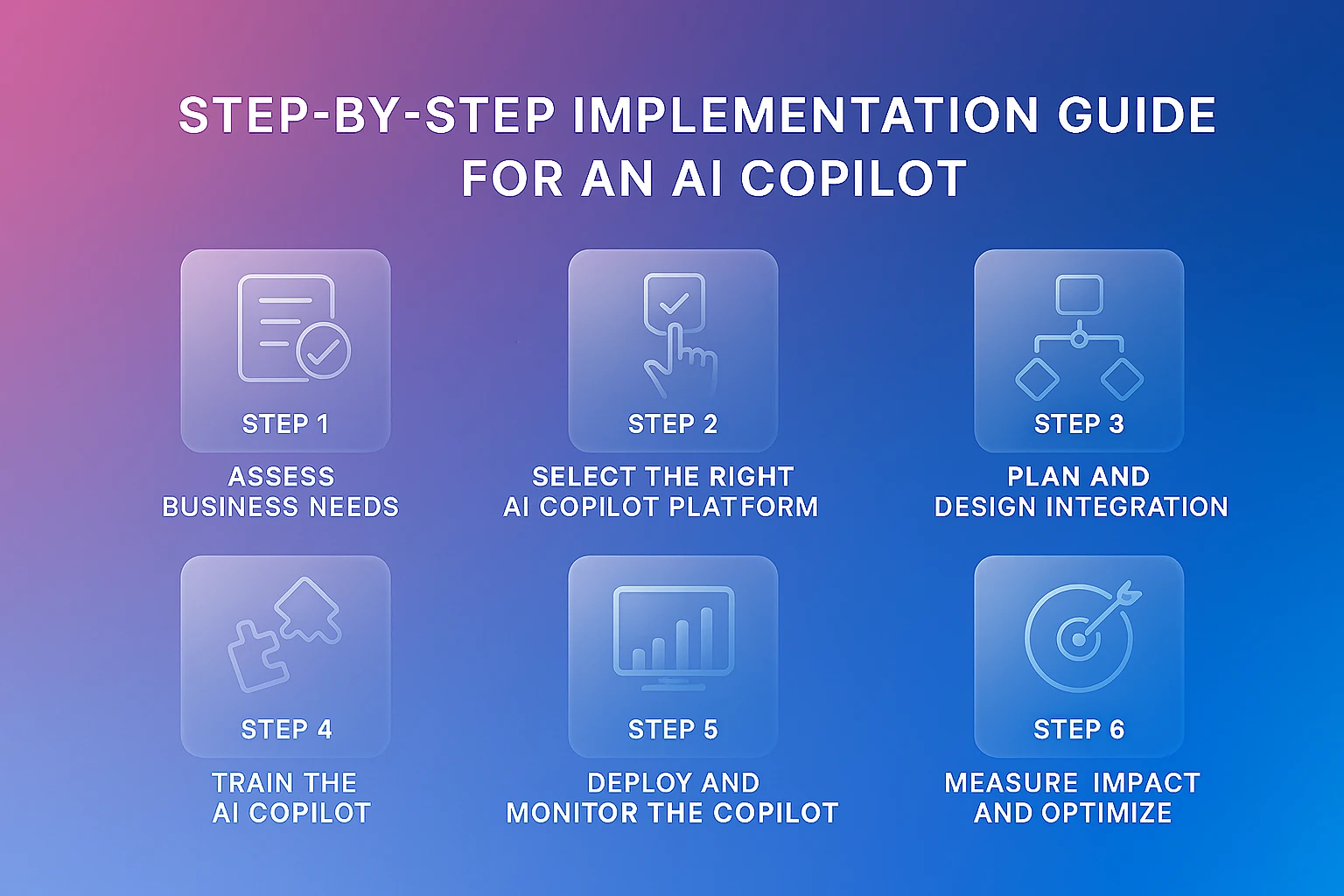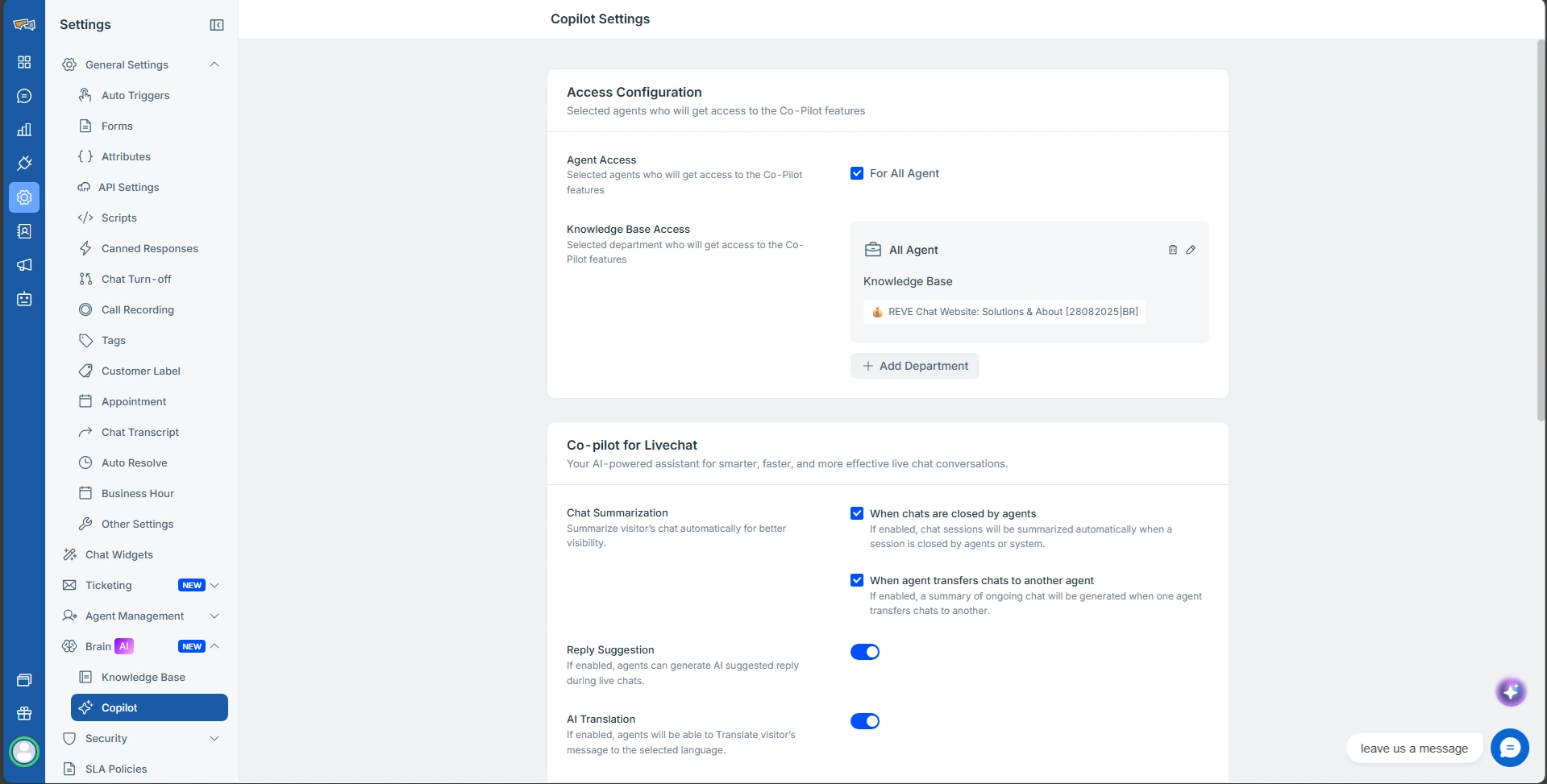How to Implement an AI Copilot: A Step-by-Step Guide for Businesses
- October 26, 2025
- 15 mins read
- Listen

What if your business could operate 40% faster without adding a single employee? AI copilots are turning this possibility into reality, acting as intelligent partners that streamline tasks, boost decision-making, and supercharge productivity.
For businesses ready to leap into the future but unsure how to harness this transformative technology, this guide is your blueprint.
It’s from assessing your needs to selecting the perfect platform and measuring ROI. In this article, we’ll walk you through every step of implementing an AI copilot.
Ready to revolutionize your operations? Let’s dive in.
Role of AI Copilot for Businesses
AI copilots are redefining the way businesses operate by acting as intelligent, collaborative partners that enhance human capabilities.
Unlike traditional automation tools, AI copilots leverage advanced machine learning and natural language processing to provide real-time insights, automate repetitive tasks, and facilitate smarter decision-making.
But what exactly does this mean for your business?
Let’s explore the transformative roles AI copilots play and why they’re becoming indispensable across industries.
1. Streamlining Workflows and Boosting Efficiency
AI copilots excel at automating routine tasks. Think data entry, scheduling, or report generation, freeing up employees to focus on high-value, creative work.
For example, in customer service, an AI copilot can handle initial inquiries, categorize tickets, and suggest responses, reducing resolution times by up to 30%.
By integrating with existing tools like CRMs or project management platforms, copilots ensure seamless workflows, minimizing disruptions and maximizing productivity.
2. Enhancing Decision-Making with Real-Time Insights
AI copilots analyze vast datasets, from market trends to internal performance metrics, delivering insights that empower leaders to make informed decisions quickly.
For instance, in retail, a copilot can predict inventory needs based on sales patterns, helping avoid stockouts or overstocking.
This data-driven approach drives agility and keeps businesses competitive.
3. Personalizing Customer Experiences
AI copilots shine by enabling hyper-personalized engagement. By analyzing customer behavior and preferences, they can recommend personalized products, craft targeted marketing messages, or even power chatbots that deliver human-like support.
Businesses using AI-driven personalization have reported up to 20% increases in customer satisfaction and retention, making copilots a game-changer for customer-centric industries.
4. Empowering Employees with Knowledge and Training
AI copilots act as on-demand mentors, providing employees with instant access to information and guidance. It’s from suggesting best practices during complex tasks to offering real-time training for new tools, copilots help bridge skill gaps.
For example, in tech support, a copilot can guide a junior technician through troubleshooting steps, reducing training time and boosting confidence.
This fosters a culture of continuous learning and adaptability.
5. Ensuring Scalability and Cost Efficiency
Growing businesses often face the challenge of scaling operations without ballooning costs. AI copilots offer a cost-effective solution by automating scalable processes and reducing reliance on manual labor.
For startups, this means achieving more with limited resources; for enterprises, it translates to optimized operations across global teams.
Studies show businesses implementing AI copilots can cut operational costs by 15-25% while maintaining or improving output quality.
Step-by-Step Implementation Guide for an AI Copilot
Are you ready to elevate your business with an AI copilot, but unsure how to get started? Implementing this transformative technology can be straightforward with a clear plan.
This guide offers a practical roadmap to integrate an AI copilot into your operations, ensuring it aligns with your goals and delivers measurable value.
Follow this journey to seamlessly adopt an AI copilot and position your business for success.

Step 1: Assess Your Business Needs and Goals
The first step in implementing an AI copilot is understanding your business’s unique challenges and objectives.
Conducting an operational audit helps pinpoint areas where an AI copilot can make a significant impact, such as automating repetitive tasks like invoice processing or providing insights for supply chain optimization.
For instance, a manufacturing firm might identify delays in production scheduling that an AI copilot could streamline with predictive analytics.
Engaging stakeholders, executives, IT, and frontline staff ensures alignment on goals, such as cutting processing times by 15% or improving order accuracy.
This process results in a focused list of objectives that guide your implementation, ensuring the copilot addresses your specific needs.
Step 2: Evaluate and Select the Right AI Copilot Platform
Choosing the right AI copilot platform is crucial for seamless integration and effectiveness. Researching solutions involves comparing features like data processing capabilities, compatibility with existing systems like ERP or CRM, and scalability.
For example, a customer support team might explore REVE Chat’s Copilot for its ability to provide instant answers from a knowledge base, enhancing response times.
Consider factors like ease of integration, customization for your industry, and cost-effectiveness. Starting with a pilot in one department, such as logistics, allows you to test the platform’s fit before full rollout.
This step delivers a shortlist of platforms with a clear rationale for your top choice, setting the foundation for success.
Step 3: Plan and Design the Integration
A thoughtful integration plan ensures the AI copilot enhances your workflows without disruption. Mapping out how the copilot will interact with current processes, such as analyzing sales data for forecasting, clarifies its role.
Defining specific use cases, like automating order tracking and setting data access permissions, ensures security and compliance.
For example, an e-commerce business might configure the copilot to suggest personalized product recommendations based on customer data. Working with your IT team to address compliance with regulations like GDPR is essential.
This step produces a comprehensive integration plan with defined workflows and security measures, paving the way for a smooth deployment.
Step 4: Train the AI Copilot and Your Team

The success of an AI copilot depends on selecting the right large language model (LLM) and properly training both the tool and your team.
Begin by choosing an LLM that aligns with your business needs, such as one optimized for natural language processing for customer support or data analysis for operational insights.
Configure access to ensure the copilot connects to relevant knowledge bases, like customer interaction logs or product databases, to refine its outputs.
For example, specifying which knowledge base to train on, such as historical sales data or technical manuals, ensures accurate, context-aware responses.
Simultaneously, set agent access controls to define who can interact with the copilot and for what tasks, maintaining security and efficiency.
Conduct employee training sessions to teach staff how to leverage the Copilot, whether for generating reports or prioritizing customer queries.
Provide clear guides and appoint a team lead to champion adoption, fostering confidence. This step delivers a finely tuned AI copilot and a workforce ready to maximize its potential.
Step 5: Deploy and Monitor the AI Copilot
A phased deployment and ongoing monitoring ensure the AI copilot meets expectations. Starting with a pilot in one area, such as order processing, allows you to test performance and gather feedback.
Monitoring metrics like processing speed or error reduction helps assess impact. For example, a logistics company might track how the copilot improves delivery scheduling efficiency.
Establishing a feedback loop with employees identifies areas for improvement, enabling gradual scaling to other functions.
This step ensures a successful initial rollout with clear performance benchmarks, setting the stage for broader adoption.
Step 6: Measure Impact and Optimize
Measuring the AI copilot’s impact validates your investment and guides future improvements. Tracking key performance indicators, such as reduced processing times or increased sales conversions, quantifies success.
For instance, a retail business might measure a 20% improvement in order fulfillment speed. Collecting feedback from employees and customers highlights gaps, while periodic reviews ensure the copilot evolves with your needs.
Optimizing based on these insights, such as expanding use cases to inventory management, maximizes value.
This step provides a clear understanding of ROI and a strategy for continuous enhancement.
Choosing the Right AI Copilot for Your Business
Selecting the perfect AI copilot for your business is a critical step that shapes the success of your implementation.
With a range of platforms available, the challenge lies in finding one that aligns with your goals, integrates seamlessly, and scales with your growth.
Let’s take a look at some key takeaways that will help you choose one faster.
Prioritize Seamless Integration
Integration with your existing tech stack is non-negotiable to avoid workflow disruptions. A good AI copilot should connect effortlessly with CRMs like Salesforce, ERPs like SAP, or collaboration tools like Slack.
For instance, a support team relying on ticketing systems might choose a platform that embeds directly into their workflow, streamlining tasks like ticket summarization.
Evaluate how well the copilot integrates with your current tools to ensure it enhances rather than complicates operations.
Evaluate User Experience
Customization ensures the AI copilot fits your industry’s unique needs. In regulated sectors like healthcare, look for platforms supporting compliance requirements, such as HIPAA or bias-free algorithms.
Platforms with flexible APIs or low-code options enable tailoring to specific workflows, such as automating financial reporting.
Equally important is an intuitive user interface, natural language prompts, and minimal learning curves, as offered by tools like ChatGPT Enterprise, which boost adoption rates across teams and reduce training time.
Balance Cost and ROI
Cost considerations extend beyond upfront pricing. Analyze subscription models, per-user fees, and additional costs like data storage or premium support.
Free tiers can be useful for testing, but enterprise-grade platforms often provide better security and reliability.
Aim for a solution where projected efficiency gains are often 15-30% based on industry studies, and justify costs within 6-12 months.
For example, investing in a platform like Salesforce Einstein could yield significant returns through enhanced CRM personalization.
Test and Validate with Pilots
Before committing, conduct demos and pilot projects to test shortlisted platforms. Review case studies and vendor support quality, including onboarding and updates, to ensure long-term reliability.
This hands-on approach confirms the platform’s fit for your business.
AI Copilot Performance Metrics and Optimization Steps
Tracking the performance of your AI copilot ensures it delivers tangible value and evolves with your business needs.
By measuring key metrics and refining its functionality, you can maximize efficiency and ROI.
Defining Key Performance Indicators (KPIs)
Start by identifying KPIs aligned with your implementation goals. For customer support, metrics like average response time, resolution rate, or customer satisfaction scores are critical.
For example, a business using an AI copilot might aim for a 25% reduction in query resolution time. In operations, track task completion speed or error rates, such as a 20% improvement in inventory forecasting accuracy.
Other KPIs include cost savings (e.g., reduced labor hours) or revenue uplift from personalized recommendations, often reported at 10-15% in retail.
Regularly monitor these metrics to quantify impact and justify investment.
Collecting and Analyzing Feedback
Feedback from employees and customers provides qualitative insights into the copilot’s effectiveness.
Conduct surveys to gauge user satisfaction. Do agents find the copilot’s suggestions helpful? Are customers happier with faster, AI-assisted responses?
For instance, a support team might report that REVE Chat’s Copilot reduces manual effort by summarizing chats.
Analyze usage data to identify underutilized features or bottlenecks, such as low adoption of real-time translation.
Combining quantitative metrics with qualitative feedback paints a complete picture of performance.
Optimizing for Continuous Improvement
Optimization is an ongoing process. Use KPI insights to refine the copilot’s algorithms, such as retraining it with updated data to improve accuracy in demand forecasting.
Expand use cases based on success, for example, if the copilot excels in customer support, apply it to marketing for personalized campaigns.
Schedule quarterly reviews to incorporate new features or integrations, ensuring the copilot adapts to evolving needs.
Engage with vendor updates to leverage enhancements in sentiment analysis or reply suggestions, keeping your system cutting-edge.
Managing Token Usage
Token usage is a key factor in optimizing an AI copilot’s cost-effectiveness and efficiency.
LLMs process inputs and outputs in tokens (units of text), and high usage can increase costs, especially for subscription-based models. Monitor token consumption during training and daily operations to balance performance with budget.
For example, limiting unnecessary queries or optimizing prompts can reduce token usage without compromising output quality.
Regularly review usage reports to identify cost-saving opportunities, such as refining data inputs or prioritizing high-impact tasks.
This approach maximizes ROI by ensuring the copilot delivers value, such as 15-30% efficiency gain,s while keeping operational costs in check.
Common Challenges and How To Overcome
Implementing an AI copilot can encounter hurdles, but proactive strategies can turn challenges into opportunities.
Below, we address common obstacles and provide practical solutions to ensure a smooth deployment.
Resistance to Adoption
Employees may resist adopting an AI copilot, fearing it will replace jobs or complicate workflows. To overcome this, communicate its role as a supportive tool that enhances, not replaces, human work.
Offer hands-on training sessions showcasing benefits, like how an AI copilot streamlines repetitive tasks.
For example, demonstrating REVE Chat’s Copilot summarizing tickets can boost agent confidence. Appointing “AI champions” to provide peer support and sharing success stories, like a 30% productivity gain, fosters buy-in.
Integration Complexities
Integrating an AI copilot with existing systems can be technically challenging, risking data silos or workflow disruptions.
To address this, collaborate with IT early to map integration points, ensuring compatibility with CRMs or ERPs. Start with a pilot in one department, like logistics, to test connectivity before scaling.
Use platforms with robust APIs to simplify integration, and consult vendor documentation or support for seamless setup.
Data Quality and Bias Concerns
Poor data quality or biases in AI outputs can undermine trust and effectiveness.
Ensure high-quality, representative data during training to improve accuracy. Regularly audit outputs for biases, such as unfair customer recommendations, and retrain the model as needed.
Transparent communication about data usage and compliance with GDPR or CCPA builds trust. Partner with legal teams to establish governance policies, ensuring ethical use.
Scaling and Cost Management
Scaling an AI copilot across departments can strain budgets or resources.
Begin with a cost-effective pilot to validate ROI before full rollout. Monitor usage to avoid overage fees, and negotiate flexible pricing with vendors.
Plan phased scaling, prioritizing high-impact areas like customer support, to balance costs with benefits, ensuring sustainable growth.
AI Copilot Business Use Cases
AI copilots are no longer futuristic concepts; they’re driving tangible transformations across industries, from boosting productivity to slashing costs and enhancing decision-making.
Whether enhancing customer support with tools like REVE Chat’s Copilot or streamlining operations with enterprise platforms, these examples showcase measurable ROI and scalable innovation.
Customer Support Optimization
AI copilots streamline customer support by automating initial inquiry responses, categorizing tickets, and suggesting context-aware replies.
Features like sentiment analysis and real-time translation, as seen in tools like REVE Chat’s Copilot. It enables faster resolution times and personalized experiences, boosting customer satisfaction while reducing agent workload.
Translation
AI copilots enable seamless multilingual communication by providing real-time translation of customer inquiries, emails, or internal documents.
This eliminates language barriers, allowing businesses to serve global markets efficiently while maintaining accuracy and cultural sensitivity. Ultimately, enhancing customer satisfaction and operational reach.
Summarization and Analysis
AI copilots excel at condensing complex data, such as lengthy reports or customer interaction histories, into concise summaries.
They provide actionable insights, enabling faster decision-making and reducing the time spent on manual data processing, which boosts overall productivity.
Data-Driven Decision Making
By analyzing vast datasets, AI copilots provide real-time insights for strategic decisions, such as forecasting demand or optimizing resource allocation.
This enhances agility in areas like inventory management or sales planning. It helps businesses make informed choices that minimize risks and maximize profitability.
Department-Wise Deployment
AI copilots can be tailored for department-specific needs, such as automating HR onboarding, optimizing finance audits, or streamlining IT support ticket resolution.
This targeted deployment maximizes efficiency across functions, ensuring each department benefits from customized automation and insights, driving organization-wide impact.
Personalized Marketing Campaigns
In marketing, AI copilots analyze customer behavior to craft tailored campaigns, recommend products, or optimize content delivery.
This hyper-personalization drives higher engagement, increases conversion rates, and strengthens brand loyalty, all while streamlining campaign management.
Employee Training and Support
AI copilots act as on-demand mentors, offering real-time guidance and best practices for complex tasks.
By providing instant access to knowledge bases and training resources. They reduce onboarding time, bridge skill gaps, and foster a culture of continuous learning.
Conclusion
What sets thriving businesses apart in 2025? It’s the bold adoption of AI copilots to drive unparalleled efficiency and innovation.
With tools like REVE Chat’s Copilot, you can streamline customer support through instant knowledge retrieval and smart response drafting, saving time and elevating satisfaction.
These intelligent partners empower your team to focus on innovation, scale operations cost-effectively, and personalize experiences like never before.
The benefits are clear: higher productivity, stronger customer loyalty, and a future-proof operation. Why wait to revolutionize your business? Sign Up for REVE Chat now and harness AI to drive unparalleled growth.




